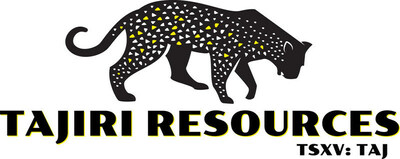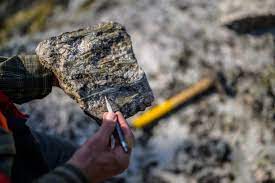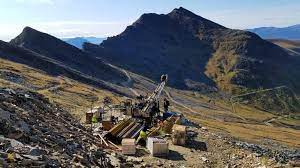Drilling News
In conjunction with auger drilling and High Grade Gold Drill results of: [email protected]/t; [email protected]/t incl. [email protected]/t; [email protected]/t incl. 1m@ 31.9g/t; [email protected]/t incl. [email protected]/t; [email protected]/t incl. [email protected]/t; [email protected]/t incl. [email protected]/t; [email protected]/t incl. [email protected]/t; [email protected]/t incl. [email protected]/t; [email protected]/t incl. 4m@ 5.8g/[email protected]/t; [email protected]/t; [email protected]/t; [email protected]/t; [email protected]/t; & [email protected]/t Tajiri confirms potential for large gold deposit at K4 North
In conjunction with auger drilling and High Grade Gold Drill results of: [email protected]/t; [email protected]/t incl. [email protected]/t; [email protected]/t incl. 1m@ 31.9g/t; [email protected]/t incl. [email protected]/t; [email protected]/t incl. [email protected]/t; [email protected]/t incl. [email protected]/t; [email protected]/t incl. 12m@5…

In conjunction with auger drilling and High Grade Gold Drill results of: [email protected]/t; [email protected]/t incl. [email protected]/t; [email protected]/t incl. 1m@ 31.9g/t; [email protected]/t incl. [email protected]/t; [email protected]/t incl. [email protected]/t; [email protected]/t incl. [email protected]/t; [email protected]/t incl. [email protected]/t; [email protected]/t incl. [email protected]/t; [email protected]/t incl. 4m@ 5.8g/[email protected]/t; [email protected]/t; [email protected]/t; [email protected]/t; [email protected]/t; & [email protected]/t Tajiri confirms potential for large gold deposit at K4 North
Canada NewsWire
VANCOUVER, BC, April 18, 2023
VANCOUVER, BC, April 18, 2023 /CNW/ – Tajiri Resources Corp. (the “Company”) (TSXV: TAJ) is pleased to detail historic Diamond, RC, Aircore and RAB drill results, that have not yet been made explicit in past announcements as they pertain to the potential of the K4-K5 prospect. This announcement focuses on drilling at K4 North only, representing approximately 5% of the area of the greater K4-5 prospect, where historic drilling has been most closely spaced but is nonetheless very widely spaced by industry standards having been conducted on a line spacings of mostly 200m 400m & 500m with limited infill at 100m line spacings.
The headlined shallow drill intercepts (almost all above 60m vertical depth) together with recently announced (March 7, 2023) saprolite auger results and extensive bedrock artisanal workings demonstrate the excellent potential for K4 North Prospect to host a very substantial gold deposit, amenable to open pit mining. The potential for the prospect to also host significant higher grades pods as evidenced by the numerous >4g/t drill intercepts over widths of 3-12m1 is also considered to be high. It is important to note that historic drilling was conducted distal to the large area of artisanal bedrock workings that span some ~ 600 x 300m at K4 North and as such drilling, despite returning handsome results, has only possibly tested areas of lessor gold mineralisation.
Location of the Reo Project and K4-5 and K4 North Prospects are shown in Figure 1. The location of the K4-North Prospect within the larger K4 Prospect (North, South and West) along with potential interpreted mineralised envelopes of interpreted fold-controlled mineralisation as shown in our March 7th 2023 press release are shown in Figure 2. Significant gold drill intercepts from K4 North are listed in Table I and shown in Figures 3 & 4.
A cross section of selected drill results, along with coincident IP results is presented in Figure 5 which demonstrates that gold mineralisation occurs in several composite zones of up to 100 metres apparent width comprised of several zones each of several tens of metres apparent widths. True width remains to be ascertained through further work.
Significant Artisanal Workings at K4 North
The area of bedrock artisanal shafts at K4 North is large and covers an impressive area of ~ 64,000 m2 (Figures 3, & 7) These workings are substantial, forming in their own right, about 1/5th of the known bedrock workings (308,000m2) within the larger K4 prospect. As such workings at K4 North compare favourably in scale to workings known to overly other large (4-7Moz) West African gold deposits (as detailed in our March 7 press release).
Furthermore, as noted in that press release and exemplified in Figures 6, 7 & 8 areas of artisanal bedrock workings closely correlate with the known extent of economic mineralisation at numerous other West African gold deposits and where no other data is available bedrock shaft workings can serve as a very good indicator of the potential scale of a deposit. In fact a general trend is for the area of artisanal bedrock workings to mostly under represent areas of drilled resources as evident at Kiaka and Namdini (Figures 7 and 8).
Beyond the absolute scale of the workings at K4 North several other features of the workings appear to indicate an excellent chance for hitherto untested mineralisation to underly the workings.
|
1) |
Artisanal mining at K4 North has been near continuous for a period of 13 years 2010-present. |
|
2) |
The K4 North shafts go deep up to 45m indicative of higher grades worth mining at depth for the artisanal miners. |
|
3) |
Artisanal bedrock workings are embedded in a much larger area of surface lateritic scrapes (Figures 9 & 10), which are about an order of magnitude greater than the bedrock workings. At other artisanal workings in West Africa bedrock workings with a small dispersion halo of surface lateritic workings tend to be associated with lower grade deposits e.g. Kiaka, Namdini, M5 (Figures 6, 7 & 8) while higher grade deposits such as M1 South (Figure 6) tend to be associated with extensive areas of surface scrapes much larger than contained bedrock workings. This is interpreted as possibly a result of coarse gold being more abundant within higher grade deposits and subsequently upon weathering forming broader deflation lags amenable to crude wind winnowing methods of gold recovery, than formed by lower grade deposits. |
|
4) |
The immediate area surrounding the K4-North artisanal bedrock saprolite shafts was mechanically excavated to depths of between 3-10m representing an estimated 750,000-1,000,000 tonnes of material moved (Figure 11). Initially the immediate area was subject to hand excavated pits, scrapes and shallow shafts, but later between 2012 and 2016 the area was mechanically mined by an organised syndicate of artisanal miners, who trucked the material to nearby watercourses where it was processed through sluice boxes. To the Company’s knowledge this was the only artisanal operation in Burkina where colluvial material was trucked for remote processing. It may therefore be inferred that the colluvium in the immediate vicinity of the K4 North artisanal shafts was particularly rich in gold to warrant such unique treatment. |
|
5) |
Due to the excavation of the colluvial pit. Mining since 2016 has only proceed during the dry season as during the wet season the colluvial pit floods. Consequently, many of the previous season’s shafts collapse and must be re-excavated. Again, we infer this as positive for potential mineralisation as the additional work required to renovate workings on an annual basis, suggests that the K4 North mineralisation is worth the exceptional effort by the artisanal miners. |
In form, the K4 North bedrock workings do not follow a linear “shear hosted” disposition, but a sinuous contorted form that strongly suggests mineralisation is localised within fold noses and is of substantial scale (Figures 11 & 12). Fold axes are interpreted to be NNW striking and the largest central fold closure evident in the workings some 120m wide with a strike length of 330m metres (Figure 12).
As such the form of workings is strongly supportive of the Company’s poly folded interpretation of mineralisation within the wider K4-K5 system and a comparison of the form of the K4-North and K4 South Artisanal workings with the form of bodies at the fold hosted Homestake deposit is shown in Figure 14.
Details of Historic Drilling
At K4 North drilling has been conducted as follows:
|
1) |
Northwest oriented lines of air-core drilling to fresh rock. Lines of this orientation were spaced 500m apart and drill holes were collared along lines at between 80-150m apart – as such this drilling exhibits large gaps between and along lines. Aircore drill holes were assayed as 4 metre composites with selected intervals re-assayed at one metre. |
|
2) |
RAB drilling on North South lines spaced 100-400m apart. Along lines RAB drilling was conducted on an irregular spacing with each successive collar along a line located above the bottom of the preceding hole and thus in theory giving horizontal coverage for any vertically dipping mineralisation. RAB holes on alternate lines were either all drilled to the south or all drilled to the north. RAB drill holes were terminated at blade refusal, for the most part being the oxide/fresh rock interface. |
|
3) |
Selective RC and Diamond drilling to follow-up better RAB and air-core intersections. All holes were drilled on a N-S azimuth with 2-5 holes testing a zone and spaced at 20-40m between collars. Most RC holes were drilled to depths of 60-100m while the deepest diamond hole was drilled to a depth of 190m at a -60 inclination. |
|
4) |
All assays were by fire assay with either a 30 or 50gram charge. |
Interpretation
Given the wide spaced drilling conducted to date it is not possible to give a definitive interpretation of the form of mineralisation represented by drill intercepts and interpretation remains highly speculative. However, as a work around a range of possible interpretations may be given with mineralisation intersected by drilling along with areas of bedrock artisanal workings utilising varying orientations and degrees of inferred continuity to arrive at a target size range.
The Company illustrates 6 possible interpretations in Figure 13 and note that the surface area of drilled and bedrock working mineralisation ranges from ~79,000 m2 to 195,800m2, the lowest area being a conservative interpretation which infers little continuity between drill intersections and the largest area inferring near continuous zones of mineralisation. Assuming a down dip continuity of 200m, average depth to fresh rock of 60m (average supported by drilling) and SGs of 1.7 and 2.65 for oxide and fresh rock respectively gives “back of the envelope” target tonnages of between 37 – 93 million tonnes for K4 North.
We however do caution that such a target tonnage remains highly speculative, with depth continuity of mineralisation being the largest unknown.
Next Exploration Steps
The company considers the following step warranted to progress exploration at K4 North:
|
1) |
Further close spaced auger drilling at K4 North on a 25 x 100m grid, with lines-oriented NE-SW, with selected areas around known drill intercepts at 12.5 x 12.5m and 25 x25m grids to define surface continuity and orientation of mineralisation between drill holes and workings. |
|
2) |
Excavation of several trenches and small 10 x10m – 20 x 20m panel pits directly over areas of bedrock workings for structural mapping and detailed sampling. |
|
3) |
Oriented diamond drilling ~ 3,000-4,000m to transect both drilled mineralisation and bed rock artisanal workings to gather structural information regarding the 3dimensional orientation of mineralisation. |
Chairman’s comments
We are pleased to note that K4 North represents a first-rate gold target with initial drilling having returned excellent results over substantial widths that are open and clearly part of a much larger system. The system is at an early stage of understanding and as such the company looks forward now to rapidly progressing exploration towards ultimately defining what could be a very substantial gold deposit.
Qualified Person
The Qualified Person under National Instrument 43-101 – Standards of Disclosure for Mineral Projects for this news release is Dominic O’Sullivan a geologist, member of the AusIMM, Executive Chairman of Tajiri who has reviewed and approved its contents.
On Behalf of the Board,
Tajiri Resources Corp.
Graham Keevil,
President & CEO
Tajiri Resources Corp. is a junior gold exploration and development Company with exploration assets located in two of the worlds least explored and highly prolific greenstone belts of Burkina Faso, West Africa and Guyana, South America. Lead by a team of industry professionals with a combined 100 plus years’ experience the Company continues to generate shareholder value through exploration.
_____________________________________
1 In the K4 North Area there are 9 intercepts better than 3m and better than 4g/t with average width and grade of 5.9m @ 6.4g/t
SOURCE Tajiri Resources Corp.
drill results
drilling
intercepts
tsxv-taj
tajiri-resources-corp
tajiri resources corp
press-release

Valhalla Metals reports 21 metres of 6.84% CuEq at Sun Project, Alaska
Valhalla Metals Inc. [TSXV-VMXX; OTCQB-VMXXF] reported assay results from four diamond drill holes totaling 1,104…
Capella Announces Definitive Agreement for the Sale of is Central Norway Copper-Cobalt Projects to NickelX and Financing Update
Capella Announces Definitive Agreement for the Sale of is Central Norway Copper-Cobalt Projects to NickelX and Financing Update
Canada NewsWire
VANCOUVER, BC, Oct. 17, 2023
VANCOUVER, BC, Oct. 17, 2023 /CNW/ – Capella Minerals Ltd (TSXV: CMIL) (OTC…
Canada Silver Cobalt Works Confirms Pegmatites up to 20 meters wide and 70 meters long at Sangster West
Pegmatite Confirmations and Advanced Geochemical Insights Propel Exploration Success
Coquitlam, BC – TheNewswire – October 17, 2023 – Canada Silver…


















